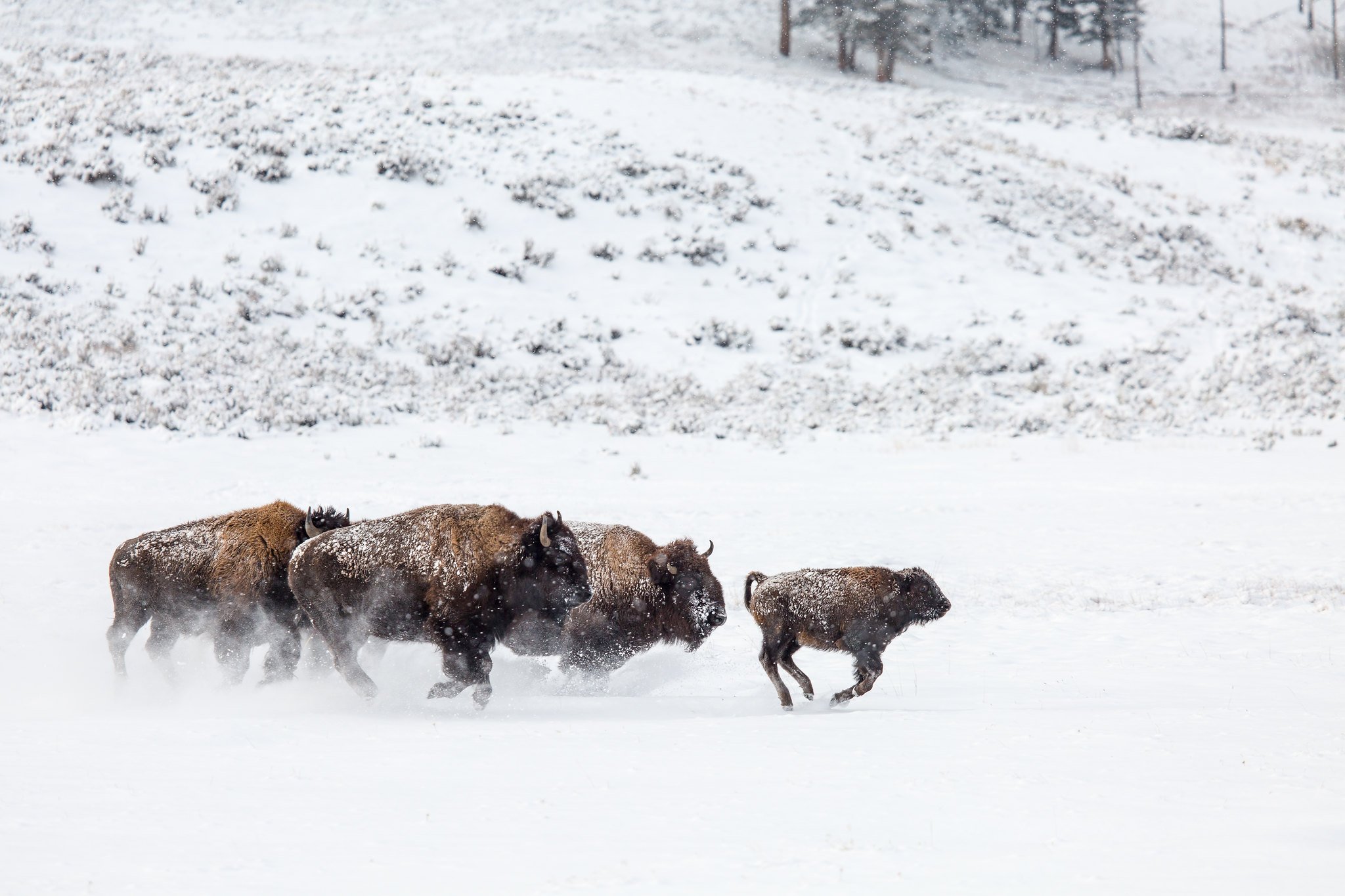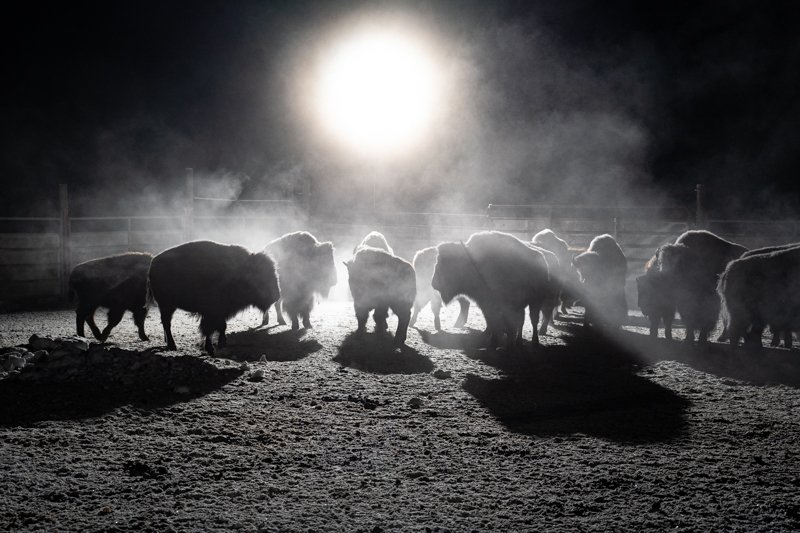Restoring bison to Tribal lands: Largest Yellowstone bison transfer a huge success
I first fell in love with bison while doing field research in Yellowstone National Park.
A component of my research as a biologist was studying bison movements and habitat use, as well as predator-prey interactions between wolves, grizzly bears, elk, and bison. But bison were always special to me—Pleistocene relics perfectly adapted to the harsh Yellowstone environment. I was struck by their incredible resiliency and toughness, equally matched by their gentleness and loyalty.
A group of bison traverse the snowy landscape in Yellowstone National Park. The Greater Yellowstone Coalition is committed to restoring Yellowstone to their ancestral habitat on Tribal and public lands across America. (Photo NPS/Neal Herbert)
As ecosystem engineers they play a critical role on the landscape; their grazing, movements and behavior literally shape the physical environment, creating new habitat for a plethora of species including amphibians and birds and promoting plant species diversity, health, and vitality. One cannot overstate their cultural significance as well and the role they played for millennia for the many Native American tribes whose whole existence and livelihoods were intimately tied to the great herds that once roamed this continent. However, despite this, bison today only occupy a small fraction of their former range—less than 1% by some estimates—and are considered by many to be ecologically extinct. In the many places where they are missing, their return to the landscape is desperately needed.
Today, I’m fortunate enough to lead the Greater Yellowstone Coalition’s bison restoration and coexistence efforts.
Yellowstone National Park bison biologist Chris Geremia (right) monitors the bison loading onto the trailers on January 12, 2023. The bison are heading to Fort Peck Indian Reservation where they’ll complete their quarantine process before being distributed to Tribal and appropriate public lands. (Photo GYC/Emmy Reed)
One of the core focuses of my work is the expansion of Yellowstone National Park’s bison quarantine program, officially known as the Yellowstone Bison Conservation Transfer Program (BCTP), which aims to divert wild Yellowstone bison from slaughter and restore them to Tribal and appropriate public lands across the country. Through the BCTP, the Park Service passively captures bison as they leave the park and moves them through a series of testing and holding facilities designed to ensure they are disease-free. The bison are then transferred to the Fort Peck Indian Reservation in northern Montana to finish their final year of quarantine before being distributed to Tribal lands across North America.
In 2021, the Greater Yellowstone Coalition raised $250,000 towards the $1 million needed to nearly triple the size of Yellowstone’s quarantine facility so that more bison could be rehomed on Tribal lands. Between January 10 and January 13, 2023, the largest bison transfer to date took place when 112 Yellowstone bison were sent to the Fort Peck Indian Reservation, including seven bulls, 53 cows, and 52 calves.
I had the incredible opportunity to see and experience the entire process, from loading the bison into their trailers in Yellowstone, to watching a reunited herd of exuberant cows and calves run off into the sunrise as they were released onto the wild and expansive landscape at the Fort Peck Indian Reservation.
After an entire day of traveling from Yellowstone National Park, a trailer holding Yellowstone bison cows prepares to be unloaded at the Fort Peck Indian Reservation facility in northern Montana. (Photo GYC/Emmy Reed)
A Yellowstone bison cow exits the trailer and runs to the overnight holding pen. Trailers were separated into cows and calves to ensure no calves were hurt by the much larger cows during the transfer. (Photo GYC/Emmy Reed)
I have done and seen a lot of incredible things in my professional career as a wildlife biologist for more than a decade before coming to GYC. But this was easily one of the most special and rewarding experiences. To see these cows and calves come running out as they were released, I could see and feel their gratitude, like they knew and understood, they are some of the lucky ones who get a second chance, a happy ending.
Yellowstone bison cows wait to be reunited with their calves at the Fort Peck Indian Reservation facility. The cows have the evening to locate their calves before being released into a larger pasture the following day. (GYC/Emmy Reed)
The Yellowstone bison herd running into their new holding pen the next morning. (Video GYC)
It was incredible to hear first-hand from Tribal members about how the bison at Fort Peck have brought meaning, connection, education, cultural revitalization, economic benefits, and healing to the people and communities there, and their immense gratitude for these bison. No doubt the impact that these bison will have on the land and people there will reverberate for generations, further solidifying the importance and absolute necessity of what we are trying to accomplish with the BCTP.
GYC’s senior wildlife conservation associate Shana Drimal (left) and Robbie Magnan, Director of the Fort Peck Fish and Wildlife Service (right) at the Fort Peck bison quarantine facility. (Photo GYC/Emmy Reed)
This is not just about saving Yellowstone bison, this is about helping to restore a way of life for the original people of these lands that was so inhumanely and inappropriately ripped away from them as Europeans settled the West. This is about reuniting Native people with the buffalo.
With this most recent transfer and because of last year’s facility expansions, Yellowstone has room to enter around 250 bison into the BCTP this winter. That’s 250 bison that will be diverted from slaughter and eventually rehomed to Tribal lands where they are missed.
We send an enormous thank you to everyone who contributed to the $250,000 raised for the Yellowstone BCTP quarantine expansion in 2021. These are your dollars at work! Because of you, these Yellowstone bison are on their way to roaming their ancestral habitat and reconnecting with Indigenous people.
It’s donors like you that make this crucial conservation work possible. Thank you!
—Shana Drimal, Senior Wildlife Conservation Associate







